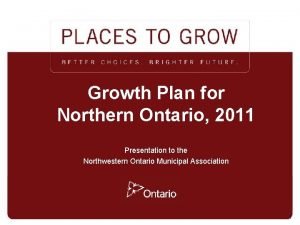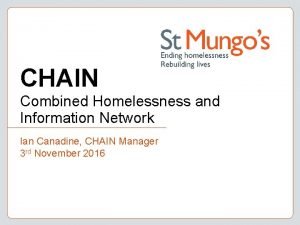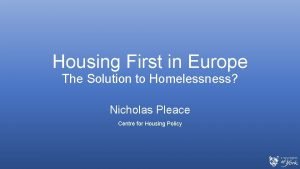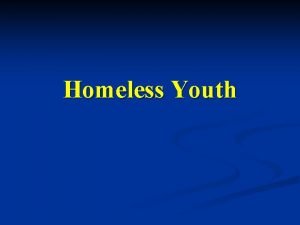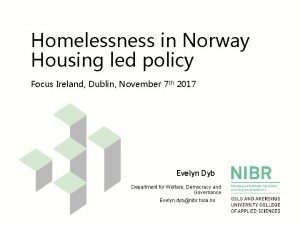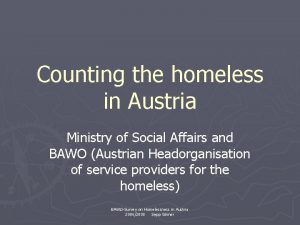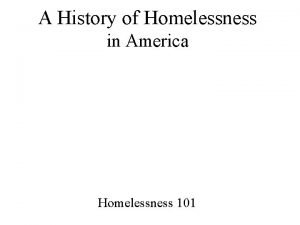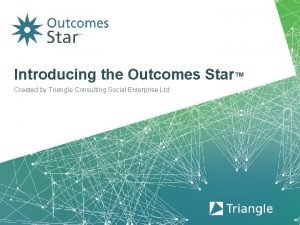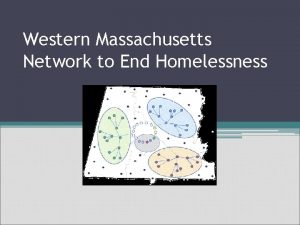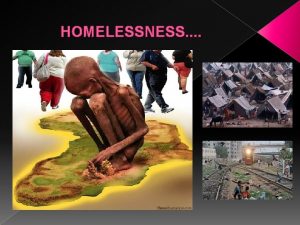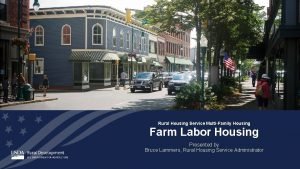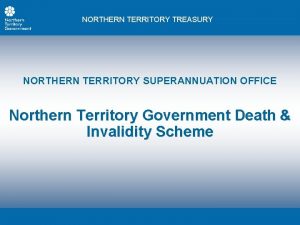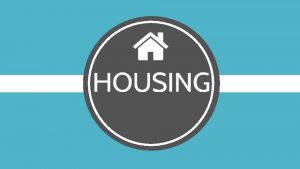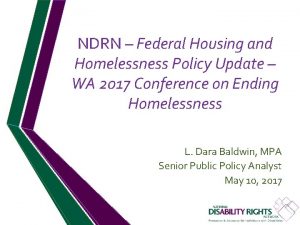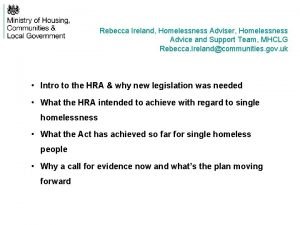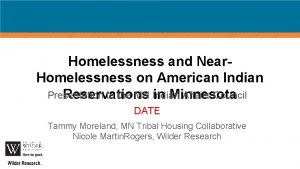Ontario Housing and Homelessness Update Northern Ontario Service
















- Slides: 16

Ontario Housing and Homelessness Update Northern Ontario Service Deliverers Association (NOSDA) Annual General Meeting Ministry of Housing June 8, 2017

Ontario’s Updated Long-Term Affordable Housing Strategy (LTAHS Update) THEMES VISION Appropriate and Sustainable Supply of Housing Equitable, Portable System of Financial Assistance People-Centred, Efficient Housing Programs Indigenous Housing Strategy Steps to End Homelessness Evidence-Informed System with Capacity to Respond Effectively to Changing Needs 2

Housing and Homelessness System Transformation Current System Transformed System • • Inadequate supply Financially unsustainable housing stock • Range of affordable housing options (private, not-for-profit, co-operative and municipal) • Social housing wait lists operate separately from other housing assistance • Coordinated access system (financial and non-financial) • Limited/inflexible financial assistance (e. g. , RGI tied to a specific unit) • Equitable, flexible and portable forms of financial assistance • Supportive housing programs managed by different ministries with different access systems • People-centred housing and support services • An emergency shelter system that helps people become stably housed 3

Promoting Affordable Housing Act, 2016 & Regulatory Changes • On December 8, 2016, Bill 7, the Promoting Affordable Housing Act, 2016 received Royal Assent. • Key elements of the legislation include: Legislative Framework for Inclusionary Zoning • Enabling Alternate Forms of Housing Assistance Local Homeless Enumeration Requirement In addition, government has made regulatory changes to provide Service Managers with greater flexibility in the delivery and administration of social housing, including: o Allowing households to retain more of their income without impacting their RGI calculation; o Allowing for more mixed income housing within the current RGI housing stock; and o Providing Service Managers and municipalities with greater potential to access capital funding for affordable housing projects. 4

Social Housing Modernization • A key component of the LTAHS Update is modernizing Ontario’s social housing programs by: o Articulating key elements for social housing programs in the future; o Undertaking some immediate reforms to support modernization; and o Committing to a process to define the path forward. • Four key elements have been identified for modernization: • Modern Program Framework More Coordinated, Effective Access System New Approaches to Financial Assistance Vibrant Not-for-Profit and Co-operative Housing Sector A Discussion Forum has been meeting over the past year (and will continue into 2018) to support modernization, which includes representation from Service Managers, social housing providers, sector organizations, Indigenous administrators of social housing, and partner ministries. 5

More Affordable Market Housing • The LTAHS Update includes several initiatives to increase the supply of affordable market housing, both homeownership and rental: Inclusionary Zoning Secondary Suites Giving municipalities the option to implement inclusionary zoning, which requires affordable housing units to be included in residential developments Making secondary suites such as abovegarage apartments or basement units in new homes less costly to build by exempting them from development charges Financial Tools Expanding/enhancing financial tools to encourage and stimulate greater private sector participation in affordable market housing development 6

Portable Housing Benefit Framework • The Ministry has developed a portable housing benefit framework – in collaboration with Service Managers and partner ministries – to provide more choice, flexibility, consistency, and certainty in the provision of housing assistance. • The framework would establish a provincial standard for a portable housing benefit that provides another way for Service Managers to meet their Service Level Standards, in addition to providing Rent-Geared-to-Income (RGI) units. • A portable benefit is a subsidy that can be calculated based on the household’s income, and provides greater flexibility and choice, since assistance is linked to the household and not to a specific RGI housing unit. • The benefit is calculated using a consistent formula using Average Market Rent (AMR) and Adjusted Family Net Income (AFNI): • • Monthly Portable Benefit Amount = (AMR x 80%) – AFNI x 30% 12 The formula is responsive to changes in: o Household income, through the use of AFNI, o Household composition, through selecting the AMR for the type of housing associated with the family composition, and o Local housing markets, through the use of local AMR. The ministry recently sought public feedback on proposed regulations that would establish the PHB Framework within the Housing Services Act, 2011. 7

Survivors of Domestic Violence – Portable Housing Benefit Pilot • The Pilot was launched in September 2016 to help survivors of domestic violence quickly access safe and affordable housing in the private rental market by providing a portable housing benefit. • Take-up by households has increased each month since the Pilot was launched, although overall take-up was lower than expected. • Initial findings indicate the Pilot is an overall success, has significant value for Special Priority Policy applicants, and appears to be a positive alternative to waiting for RGI housing. • Budget 2017 announced $30 million over the next three years for the Pilot to eventually assist up to 3, 000 survivors of domestic violence; details for this funding will follow. 8

Ending Homelessness Poverty Reduction Strategy 2014 -2019 Long-term Goal to End Homelessness Expert Advisory Panel on Homelessness Goal to End Chronic Homelessness by 2025 9

Ending Homelessness (cont’d) Provincial Priority Areas Chronic Community Profiles Youth Local Homeless Enumeration Indigenous Youth Labs Transitions Working Group 10

Supportive Housing Transformation • • • As part of the LTAHS Update, the province committed to the long-term transformation of the supportive housing system. Transformation is occurring through a whole of government approach, led by the Ministry of Housing (MHO), Ministry of Health and Long-Term Care (MOHLTC), Ministry of Community and Social Services (MCSS), and Ministry of Children and Youth Services (MCYS) and informed by people living in supportive housing. On March 9, 2017, the province released the Supportive Housing Policy Framework and Best Practice Guide. Supportive Housing Investment • Also on March 9, 2017, the province announced an additional investment to make significant progress towards the government’s goal of ending chronic homelessness by 2025. • The province is investing up to $200 million in operating funding for housing assistance and support services to assist up to 6, 000 families and individuals over the next three years. • The investment will also support the construction of up to 1, 500 new supportive housing units over the longterm. 11

Indigenous Housing Strategy • Through the LTAHS Update, the government committed to work in partnership with Indigenous organizations to develop an Indigenous Housing Strategy. • The Indigenous Housing Strategy Engagement Table includes participation from: o Ontario Federation of Indigenous Friendship Centres, Ontario Native Women’s Association, Métis Nation of Ontario; o Ontario Aboriginal Housing Services and Miziwe Biik Development Corporation (Indigenous housing program administrators); and o Gignul Non-Profit Housing Corporation and Nishnawbe Homes (nominated by the Ontario Non-Profit Housing Association’s Urban Aboriginal Advisory Committee). • The Table has met seven times since summer 2016 with continued discussions planned into fall 2017. • The ministry is also undertaking broader outreach beyond the table with other Indigenous organizations, including Chiefs of Ontario, Political Territorial Organizations, other First Nations, and Tungasuvvingat Inuit. • The ministry has also been engaging with Service Managers to hear their perspectives and priorities for the Strategy. 12

Innovation, Evidence and Capacity Building Fund Objectives: • Increase local sector capacity to manage change, develop new skills and/or take advantage of new opportunities. • Encourage evidence-based orientation and/or a culture of continuous improvement within the housing and homelessness sector. • Support system capacity for at least one of themes of the LTAHS Update. Approach: • 2016 -17: Targeted approach involving identification of six initiatives by the ministry. • 2017 -18: Open call issued combined with a targeted approach. Funding: 2016 -17 $M 2017 -18 $M 2018 -19 (Ongoing) $M 0. 50 1. 00 13

Housing and Homelessness Data Strategy • The ministry is implementing a Housing and Homelessness Data Strategy to improve its ability to collect and manage data and to encourage a culture of data sharing across the housing and homelessness system. Data Acquisition + Collection Infrastructure + Analysis Data Governance + Management • Development of a Data Acquisition Plan • Data Forum with Service Managers • Development of a Data Portal • Development of data management resources and protocols Skills Development + Training • Building sector capacity 14

National Housing Strategy • Ontario is continuing to work with the federal government and other provinces and territories to develop a National Housing Strategy (NHS) to be publicly released late in 2017. • Ministers met in Ottawa on November 1, 2016 to agree on a vision, outcomes, and principles for the NHS and will meet again in the summer and fall to review and finalize the NHS. • The NHS will include the $11. 2 billion federal investments in housing and homelessness initiatives as announced in the 2017 federal budget. $3. 2 billion of this funding will be delivered by the provinces and territories. • An Indigenous Housing Strategy and the redesigned Homelessness Partnering Strategy are part of the NHS but on a different timeline. • Ontario is working towards funding that is flexible enough to account for local needs and circumstances to preserve social housing stock and housing affordability as operating agreements expire. 15

Ontario’s Fair Housing Plan • On April 20 th, 2017, the government introduced the Fair Housing Plan: a comprehensive package of measures to help more people find affordable homes, increase housing supply, protect buyers and renters, and enable information sharing, while bringing stability to the real estate market. • Measures under the Fair Housing Plan include: Address Demand Protect Renters Increase Housing Supply Further Protections/ Information Sharing 15 percent Non. Resident Speculation Tax on the price of homes in the Greater Golden Horseshoe Expand rent control and further protect renters Leverage the value of surplus provincial lands for new market and affordable housing Tackle tax avoidance and speculation Bill 124, the Rental Fairness Act received Royal Assent on May 30, 2017. Aligning new multi-residential and residential property taxes Improve real estate practices New targeted $125 M five-year development charges rebate program Provincial Housing Forum Property tax flexibility for municipalities, including a higher tax rate on vacant residential land Educate homebuyers on real estate rights Improve tax collection Municipal vacant homes tax Improve elevator service Housing Supply Team/Development Approval Roundtable Growth Plan provisions 16
 What is an alternative of log based recovery
What is an alternative of log based recovery Growth plan for northern ontario
Growth plan for northern ontario Off campus transfer student housing in flagstaff
Off campus transfer student housing in flagstaff Chain homelessness
Chain homelessness Finland homelessness solution
Finland homelessness solution Homelessness
Homelessness Youth homelessness definition
Youth homelessness definition Michigan campaign to end homelessness
Michigan campaign to end homelessness Abolish homelessness
Abolish homelessness Causes of homelessness orange county
Causes of homelessness orange county Homelessness in norway
Homelessness in norway Homeless in austria
Homeless in austria Timeline of homelessness in america
Timeline of homelessness in america Typology
Typology The bill homelessness was
The bill homelessness was Homelessness outcome star
Homelessness outcome star Western mass network to end homelessness
Western mass network to end homelessness

